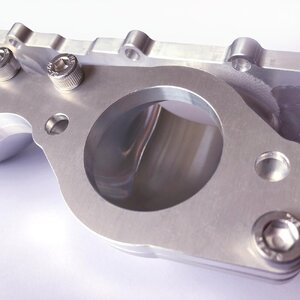waxhead
wannabe backflipper
- Location
- gold coast
When you're working on optimizing a two-stroke engine, the intake system's design is one of the most critical aspects to get right. It might be tempting to think that maximizing the volume of air delivered to the engine is the way to go, but in reality, the speed—or velocity—of the air-fuel mixture is what you should be focusing on. Prioritizing velocity in your intake manifold can significantly boost your engine's performance.
In two-stroke engines, both velocity and flow are important, but they play different roles. Flow is all about the quantity of air-fuel mixture that the engine receives, typically measured in cubic feet per minute (CFM). Essentially, it’s about how much mixture is getting through the intake system. On the other hand, velocity is concerned with the speed at which that mixture is moving through the intake, into the crankcase, and ultimately into the combustion chamber. This speed, measured in feet per second (FPS), is crucial for ensuring the engine is filled efficiently and performs at its best.
While it’s true that having a good flow rate can be beneficial, the key to really maximizing power and efficiency in a two-stroke engine lies in getting the velocity right.
For instance, when the intake charge first enters the crankcase in a two-stroke engine, it’s essential that it does so quickly and efficiently. This quick filling is crucial for maintaining the engine's power output. If the intake charge moves too slowly, the crankcase may not fill completely, leading to a dip in performance.
Scavenging, the process where the fresh air-fuel mixture pushes out the spent exhaust gases, also benefits from high intake velocity. A faster-moving intake charge has the momentum needed to clear out the exhaust gases effectively, resulting in a cleaner charge and more complete combustion, which in turn boosts power and efficiency.
Moreover, the faster the air-fuel mixture moves through the intake, the better it mixes and atomizes. This improved mixing is especially important in two-stroke engines because the quality of combustion relies heavily on the consistency of the mixture. A well-atomized mixture burns more completely, producing more power and reducing the chances of unburned fuel escaping into the exhaust.
Another advantage of high intake velocity is its impact on volumetric efficiency. This refers to the engine’s ability to fill its combustion chamber with the air-fuel mixture. By ensuring the mixture is drawn into the engine at high speed during each intake cycle, you’re maximizing the amount of air and fuel that enters the engine, which is particularly important in two-stroke engines where the time available for intake is limited.
Finally, high intake velocity helps to prevent reversion, which is when the air-fuel mixture flows backward into the intake during certain phases of engine operation. By maintaining a steady forward flow, high velocity ensures the mixture continues into the cylinder, rather than being pushed back into the intake tract, which can severely affect performance.
When designing or optimizing an intake system for a two-stroke engine, it’s essential to focus on factors that maintain high velocity. This includes optimizing the reed valve design, carefully matching the intake port shape and size to the engine’s needs, selecting the correct carburetor size, and ensuring the intake tract length is balanced with the engine’s overall tuning. Proper jetting is also crucial, as it helps maintain the consistency of the air-fuel mixture, preventing issues that can arise from either a too-rich or too-lean condition, both of which can affect velocity and overall performance.
In conclusion, when it comes to two-stroke engines, focusing on velocity rather than just flow can lead to significant performance gains. By ensuring the air-fuel mixture is delivered quickly and efficiently, you can improve crankcase filling, enhance scavenging, and boost the overall efficiency of the engine. Whether you’re fine-tuning your current setup or designing a new engine from scratch, keeping velocity at the forefront of your decisions will help you achieve the best possible performance. After all, in a two-stroke engine, it’s not just about how fast you go—it’s about how fast the air-fuel mixture gets there.
When we designed the Wax Racing intake, we spent a lot of time ensuring that there were no variations in the runner along the way. This was crucial for keeping the velocity as high as possible without restricting airflow. We also made sure that the exit speed of the manifold was maximized and shaped in a way that reduces reversion and stand-off in your intake tract. The result is an intake manifold that not only delivers optimal performance but also maintains the consistency and efficiency that high-performance engines demand.
In two-stroke engines, both velocity and flow are important, but they play different roles. Flow is all about the quantity of air-fuel mixture that the engine receives, typically measured in cubic feet per minute (CFM). Essentially, it’s about how much mixture is getting through the intake system. On the other hand, velocity is concerned with the speed at which that mixture is moving through the intake, into the crankcase, and ultimately into the combustion chamber. This speed, measured in feet per second (FPS), is crucial for ensuring the engine is filled efficiently and performs at its best.
While it’s true that having a good flow rate can be beneficial, the key to really maximizing power and efficiency in a two-stroke engine lies in getting the velocity right.
For instance, when the intake charge first enters the crankcase in a two-stroke engine, it’s essential that it does so quickly and efficiently. This quick filling is crucial for maintaining the engine's power output. If the intake charge moves too slowly, the crankcase may not fill completely, leading to a dip in performance.
Scavenging, the process where the fresh air-fuel mixture pushes out the spent exhaust gases, also benefits from high intake velocity. A faster-moving intake charge has the momentum needed to clear out the exhaust gases effectively, resulting in a cleaner charge and more complete combustion, which in turn boosts power and efficiency.
Moreover, the faster the air-fuel mixture moves through the intake, the better it mixes and atomizes. This improved mixing is especially important in two-stroke engines because the quality of combustion relies heavily on the consistency of the mixture. A well-atomized mixture burns more completely, producing more power and reducing the chances of unburned fuel escaping into the exhaust.
Another advantage of high intake velocity is its impact on volumetric efficiency. This refers to the engine’s ability to fill its combustion chamber with the air-fuel mixture. By ensuring the mixture is drawn into the engine at high speed during each intake cycle, you’re maximizing the amount of air and fuel that enters the engine, which is particularly important in two-stroke engines where the time available for intake is limited.
Finally, high intake velocity helps to prevent reversion, which is when the air-fuel mixture flows backward into the intake during certain phases of engine operation. By maintaining a steady forward flow, high velocity ensures the mixture continues into the cylinder, rather than being pushed back into the intake tract, which can severely affect performance.
When designing or optimizing an intake system for a two-stroke engine, it’s essential to focus on factors that maintain high velocity. This includes optimizing the reed valve design, carefully matching the intake port shape and size to the engine’s needs, selecting the correct carburetor size, and ensuring the intake tract length is balanced with the engine’s overall tuning. Proper jetting is also crucial, as it helps maintain the consistency of the air-fuel mixture, preventing issues that can arise from either a too-rich or too-lean condition, both of which can affect velocity and overall performance.
In conclusion, when it comes to two-stroke engines, focusing on velocity rather than just flow can lead to significant performance gains. By ensuring the air-fuel mixture is delivered quickly and efficiently, you can improve crankcase filling, enhance scavenging, and boost the overall efficiency of the engine. Whether you’re fine-tuning your current setup or designing a new engine from scratch, keeping velocity at the forefront of your decisions will help you achieve the best possible performance. After all, in a two-stroke engine, it’s not just about how fast you go—it’s about how fast the air-fuel mixture gets there.
When we designed the Wax Racing intake, we spent a lot of time ensuring that there were no variations in the runner along the way. This was crucial for keeping the velocity as high as possible without restricting airflow. We also made sure that the exit speed of the manifold was maximized and shaped in a way that reduces reversion and stand-off in your intake tract. The result is an intake manifold that not only delivers optimal performance but also maintains the consistency and efficiency that high-performance engines demand.





